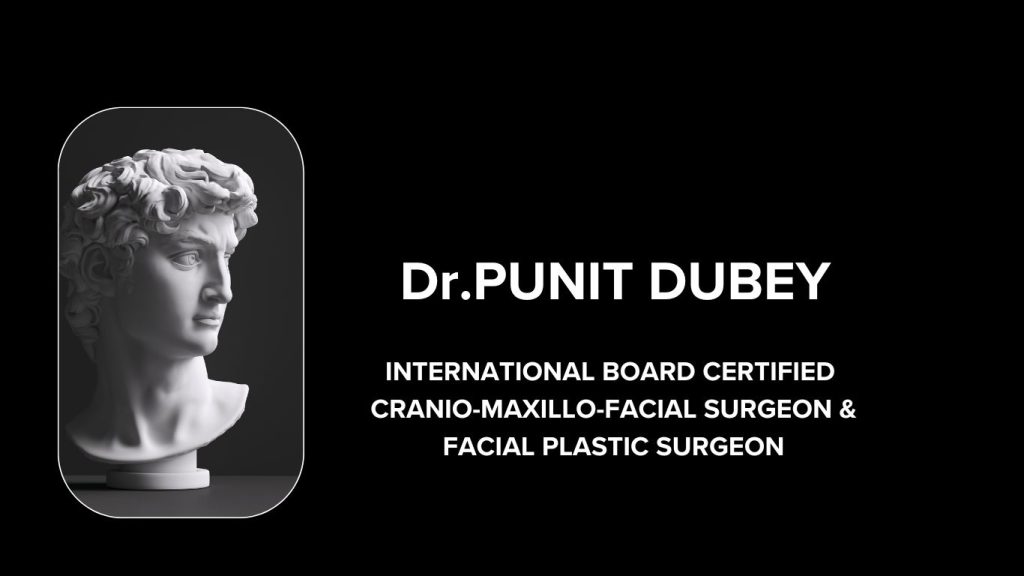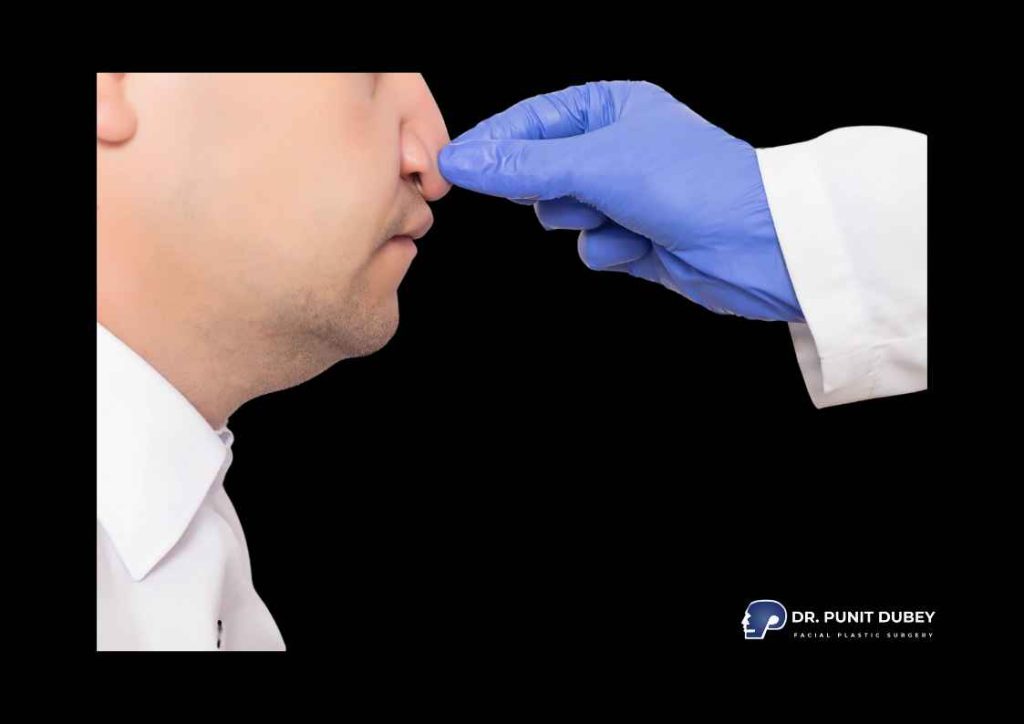
Septoplasty Surgery in Delhi, India
Struggling to breathe through your nose? Constantly congested on one side? You’re not alone — and it might be more than just allergies or a cold. A large number of individuals in India unknowingly suffer from a deviated septum, often mistaking their symptoms for allergies or a minor cold. The good news? Relief is possible through septoplasty surgery in Delhi.
Whether you’re waking up with blocked nostrils, suffering from sinus infections, or experiencing headaches and snoring, septoplasty is a life-changing solution that can improve your breathing, sleep quality, and overall well-being. And if you’re in Delhi, you’re in one of the best places in the country for this advanced nasal surgery — especially under the skilled hands of Dr. Punit Dubey is an internationally trained expert in both facial plastic and jaw surgery, with advanced training in nasal correction procedures like septoplasty and rhinoplasty.
But what exactly is septoplasty surgery? How long does it take? Is it painful? What does recovery look like?
This comprehensive guide will answer all your questions — and more — so you feel confident and informed about taking the next step toward easier breathing and a better quality of life.
Table of Contents
What is Septoplasty Surgery?
A Straight Path to Better Breathing
Septoplasty is a corrective nasal procedure that aims to fix alignment issues in the septum — the thin wall inside your nose made of cartilage and bone, dividing the left and right airways. When this wall is off-center (which it often is, especially after trauma or genetic development), it can restrict airflow, cause frequent sinus infections, nasal congestion, facial pain, and even sleep disorders like snoring or sleep apnea.
Imagine your nasal passage as a two-lane tunnel — if one lane is crooked or blocked, the airflow suffers. Septoplasty rebuilds that passage, restoring a smooth and balanced airway.
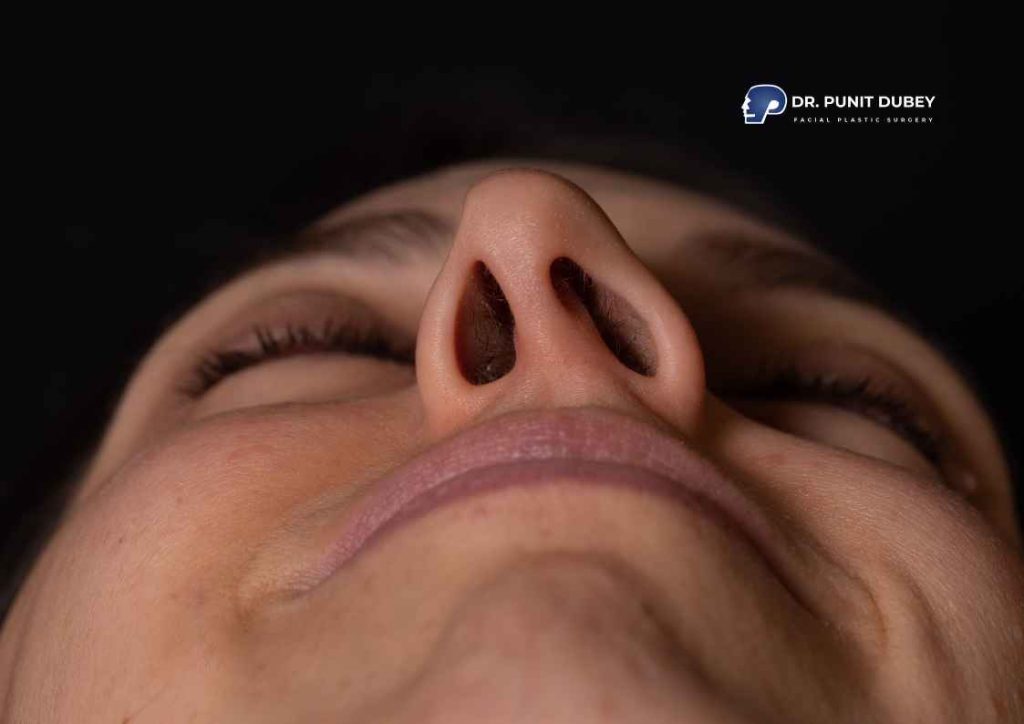
What Does Septoplasty Mean in Medical Terms?
The term “septoplasty” literally means the surgical repair (plasty) of the nasal septum. It’s often confused with rhinoplasty, which is a cosmetic reshaping of the nose. While rhinoplasty focuses on appearance, septoplasty focuses on function — though both can be done together in a single procedure called septorhinoplasty.
Understanding Deviated Nasal Septum
What Is a Deviated Septum — And Why Does It Matter?
Your nasal septum is the central wall that divides your nose into two chambers. Ideally, this wall should be straight and centered. However, in many individuals — up to 80% of the population — it’s at least slightly deviated, meaning it bends to one side.
When that bend becomes severe, it can partially or completely block one side of the nose, leading to:
- Chronic nasal congestion
- Noisy or obstructed breathing during sleep
- Frequent sinus infections
- Reduced sense of smell
- Post-nasal drip or nosebleeds
- Headaches and facial pressure
This condition is commonly referred to as Deviated Nasal Septum (DNS) or nasal septum deviation.
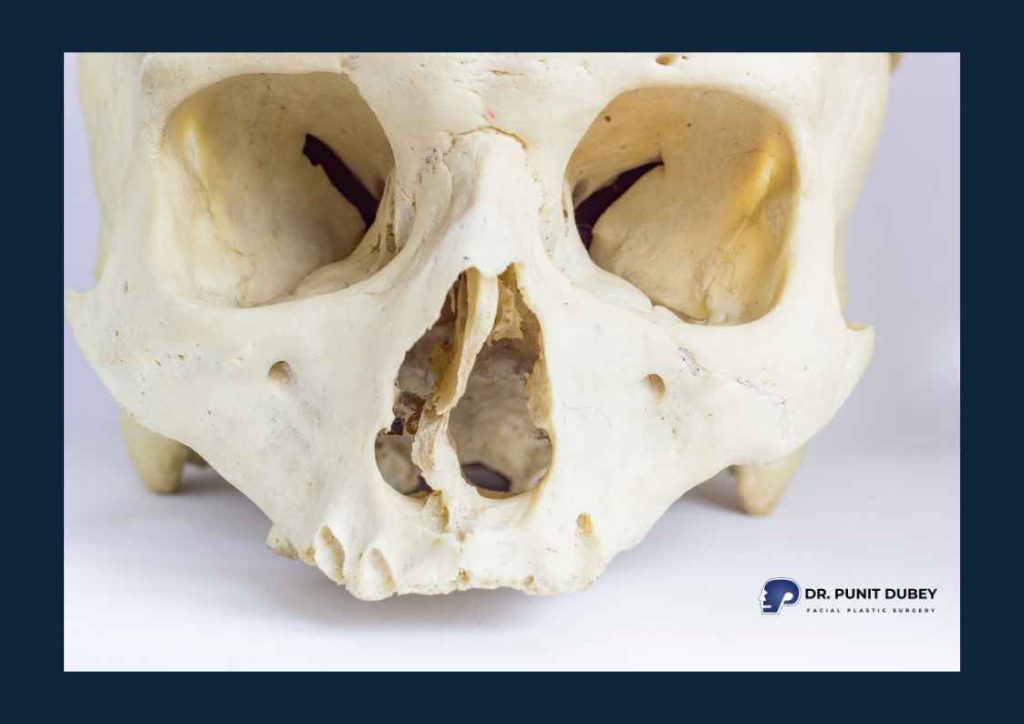
Causes of a Deviated Septum
A deviated septum can be:
- Present at birth (congenital): Often caused by irregular growth patterns during development.
- Injury-related (acquired): Resulting from facial trauma, such as sports collisions or accidents.
- Aging-related – cartilage shifts over time
DNS is often underdiagnosed because people assume blocked noses are due to dust or allergies. However, DNS tends to cause persistent nasal breathing problems, unaffected by decongestants or antihistamines.
How Is It Diagnosed?
A maxillofacial surgeon or facial plastic surgeon, like Dr. Punit Dubey, can evaluate DNS through:
- Nasal endoscopy
- CT scans or X-rays (in complex cases)
- Physical examination and symptom history
The goal of diagnosis is to determine whether the septum’s deviation is severe enough to require septoplasty surgery for correction.
When Is Surgery Needed?
While minor deviations may be managed with medication, moderate to severe deviations that affect breathing, sleep, or sinus health often require septoplasty or septoplasty with FESS (Functional Endoscopic Sinus Surgery).
If you’re constantly breathing through your mouth, snoring loudly, waking up tired or obstructive sleep apnea, you could be an ideal candidate for surgery.
Types of Septoplasty Surgery
When it comes to correcting a deviated nasal septum, there isn’t a one-size-fits-all approach. The type of septoplasty surgery recommended depends on the severity of the deviation, associated nasal conditions (like enlarged turbinates or sinus blockages), and whether a cosmetic change is also desired.
Let’s break down the most common techniques:
- Open Septoplasty Surgery
In open septoplasty, a small external incision is made on the columella (the soft tissue between your nostrils), giving the surgeon complete visibility and access to the nasal structures. This approach is preferred when:
- In some cases, the deviation occurs deeper within the nasal cavity or involves more intricate structural twists, making it more complex to correct.
- Combined procedures like rhinoplasty are planned
- Cartilage grafting or structural support is needed
Pros:
- Better visualization of deep or complicated defects
- Ideal for revision cases or patients undergoing septorhinoplasty
- More control over nasal reshaping
Cons:
- Slight external scar (though usually minimal and fades over time)
- Slightly longer healing period
- Closed Septoplasty Surgery
Closed septoplasty is performed through incisions placed entirely within the nose, ensuring the external skin remains untouched and scar-free. This is the standard approach for:
- Mild to moderate septal deviations
- Patients focused solely on improving breathing without cosmetic changes
Pros:
- No visible scarring
- Faster recovery time
- Shorter surgery duration
Cons:
- Limited visibility for complex deformities
- Not ideal for combined cosmetic work
- Endoscopic Septoplasty Surgery
This modern technique uses a tiny camera (endoscope) inserted through the nostril to guide the surgeon. This technique enables accurate realignment of the septum while preserving nearby nasal tissues, reducing surgical trauma. In Delhi, endoscopic septoplasty is increasingly favoured because of its minimally invasive approach and quicker recovery outcomes:
- Less bleeding
- Lower risk of complications
- Quicker recovery
It’s especially useful in cases involving sinus issues or when the deviation is localized to a specific area.
- Laser-Assisted Septoplasty
Laser septoplasty is an emerging technique where laser energy is used to reshape and soften cartilage. While still under evaluation for long-term results, it offers:
- Minimal cutting
- Less intraoperative bleeding
In selected patients, this method may even be done in an outpatient setting, eliminating the need for overnight hospital stays.
Each of these types has its own advantages and indications. During your consultation, your surgeon will determine which technique is best suited to your condition, anatomy, and expectations.
Ideal Candidates for Septoplasty Surgery
Not everyone with a deviated septum requires surgery — but if your daily life is affected by breathing issues, chronic congestion, or frequent sinus infections, you might be an ideal candidate for septoplasty surgery.
You May Be a Good Candidate If You Have:
- Ongoing problems with airflow through either one or both sides of the nose, even during rest or sleep.
- Difficulty breathing through your nose, especially during sleep or exercise
- Frequent sinus infections that don’t respond to medications
- Structural blockages in the nose that contribute to snoring or light forms of sleep apnea.
- An uneven or misshaped nasal bridge due to trauma or a birth-related deformity.
- Mouth breathing, particularly at night
- Poor sense of smell or loss of smell (anosmia) associated with blockage
You May Not Be a Good Candidate If:
- You have an active nasal or sinus infection
- You have not yet completed nasal growth (typically under age 16–17)
- You expect cosmetic changes only — in that case, rhinoplasty or septorhinoplasty may be more appropriate
- You have uncontrolled medical conditions that increase surgical risks
Septoplasty vs. Medication: When Surgery Becomes Necessary
For minor septal deviations, doctors may initially try nasal sprays, antihistamines, or decongestants. However, these only offer temporary relief and do not correct the anatomical problem.
When symptoms persist despite medical therapy, or if the septal deviation is clearly visible or physically obstructive, septoplasty surgery becomes the definitive treatment.
The Role of Combined Procedures
If you also have:
- Enlarged turbinates
- Chronic sinusitis
- Nasal polyps
- Or want aesthetic correction
Your surgeon may suggest a combined surgery, such as:
- Septoplasty is often performed alongside FESS (Functional Endoscopic Sinus Surgery) when sinus issues also require correction.
- Septoplasty + Turbinoplasty
- Septoplasty + Rhinoplasty
This comprehensive approach ensures both function and appearance are addressed in one go.
The Process of Septoplasty Surgery in Delhi
Choosing to undergo septoplasty surgery in Delhi means getting access to world-class medical infrastructure, advanced endoscopic techniques, and skilled surgeons like Dr. Punit Dubey, who blends precision with experience. Let’s walk through the entire journey — from your first consultation to the day of the operation.
Initial Consultation
Your journey begins with a thorough assessment by a qualified maxillofacial or facial plastic surgeon. This includes:
- A nasal endoscopy to visualize the internal deviation
- CT scan or imaging if the deviation is complex or involves sinuses
- Going over your previous health records and discussing any ongoing nasal complaints.
- Discussion of your goals (functional vs aesthetic)
During this consultation, your doctor will also:
- Explain whether you need just septoplasty, or a combined procedure like septoplasty and FESS, or septorhinoplasty
- Show before and after septoplasty surgery results from similar cases
Your surgeon will explain each phase of the procedure, including pre-op prep, the surgery itself, and what recovery will involve. You’ll also receive guidance on insurance coverage if applicable, and a personalized treatment plan based on your nasal anatomy and breathing patterns.
Pre-Surgery Preparations
- Several weeks prior to your surgery, you’ll receive a checklist of pre-operative instructions to follow.
- Stop blood-thinning medications (like aspirin or ibuprofen)
- Avoid smoking or alcohol (as they delay healing)
- Undergo routine blood tests, ECG, or chest X-rays (if required)
Some helpful tips before surgery include:
- Arrange for a 1–2 day leave from work or school
- Prepare soft foods (for post-op comfort)
- Sleep well the night before — don’t skip meals unless advised
You’ll also be advised on:
- Diet before and after septoplasty surgery
- What to bring on the day (insurance documents, someone to accompany you)
- What to expect during nasal packing or splinting post-op
Septoplasty Surgery Procedure

On the day of the procedure:
- Anesthesia: Most septoplasty procedures are done under local anesthesia with sedation or general anesthesia, depending on the case complexity and surgeon preference.
- Surgical Time: The average septoplasty surgery time is 30 to 90 minutes depending on technique and whether it’s combined with other procedures.
Here’s a step-by-step overview of the septoplasty procedure:
- Incision inside the nostril (in closed technique) or at the columella (for open septoplasty)
- Elevation of mucosal lining from the cartilage and bone
- Trimming, reshaping, or repositioning of the deviated parts
- If necessary, grafts or splints are placed for structural support
- Mucosal flaps repositioned and sutured
- Nasal packing or soft internal splints may be inserted to support healing
Most patients go home the same day, and full recovery begins within hours after surgery.
Septoplasty Surgery Recovery Time
Immediate Post-Surgery (Day 1–2)
- Most patients are discharged within a few hours and don’t need an overnight hospital stay.
- Nasal packing or internal splints may be placed to support healing and reduce bleeding — these can feel uncomfortable but are temporary.
- Mild pain, nasal pressure, or headache is normal and manageable with prescribed medications.
- Slight bleeding or a blood-tinged discharge is expected for the first 24–48 hours.
Signs to Watch Out for After Septoplasty Surgery
- Persistent bleeding beyond a few days
- High fever or chills
- Green/yellow nasal discharge (may indicate infection)
- Severe or worsening pain
- Nose still blocked months after septoplasty — this may signal underlying issues that need review
Day-by-Day Septoplasty Recovery Tips
Day | Recovery Milestone |
Day 1 | Mild swelling, packing in nose |
Day 3 | Packing/splints removed, discomfort eases |
Day 7 | Return to light work, breathing improves |
Day 14 | Normal activities resume, swelling minimal |
Week 6 | Full healing internally, clear breathing |
Month 3 | Final results visible, airway stable |
Benefits of Septoplasty Surgery
Struggling to breathe freely through your nose can impact your energy, sleep, and focus. Septoplasty offers long-term relief by correcting the root structural issue: a misaligned nasal septum. Here’s how patients benefit:
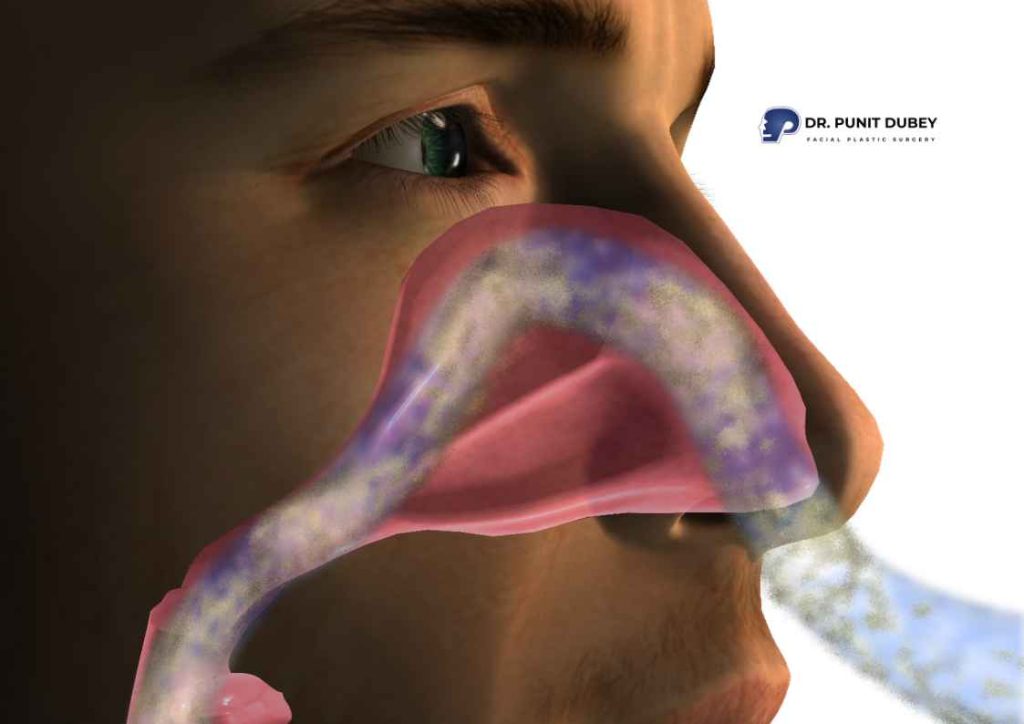
- Easier Breathing Through Both Nostrils
Patients often notice significantly better airflow right after the procedure. The feeling of persistent congestion disappears as nasal passages open evenly — many compare it to “finally taking a full breath.”
- Fewer Sinus Problems and Facial Discomfort
By restoring normal sinus drainage, septoplasty reduces the frequency of sinus infections, pressure buildup, and tension headaches caused by poor airflow and bacterial growth.
- Improved Sleep Quality
With the nasal passage cleared, patients often report less snoring, fewer nighttime awakenings, and deeper sleep — especially if they were habitual mouth breathers before surgery.
- Better Daily Functioning
Ongoing nasal obstruction may lead to tiredness, mood swings, and trouble focusing. Correcting it often improves mental sharpness and daily comfort.
- Enhanced Results with Combined Procedures
For patients combining septoplasty with rhinoplasty or sinus surgery, outcomes tend to be more complete — structurally and aesthetically. Doing both in one sitting can also reduce costs and recovery time.
- Long-Term Correction
Unlike nasal sprays or antihistamines that offer short-term relief, septoplasty resolves the issue permanently by fixing the structural deviation.
- No Visible Scars, Fast Recovery
Modern approaches like endoscopic and closed septoplasty ensure that recovery is quick and cosmetic concerns are minimal — most patients resume normal life within a week.
Septoplasty Surgery Side Effects
While generally safe, septoplasty is still surgery — and knowing the possible risks helps set realistic expectations. Fortunately, most side effects are short-lived.
- Minor Bleeding
A small amount of bleeding or pinkish discharge is normal for the first day or two and is typically controlled with internal nasal support.
- Temporary Blockage and Swelling
Initial puffiness and nasal congestion are common due to internal swelling and any post-surgery packing. Relief improves after a few days.
- Headaches or Pressure
Mild headaches or sinus pressure may occur in the first week but usually fade with rest, hydration, and prescribed pain medication.
- Risk of Infection (Rare)
Infections are uncommon but can arise if post-op hygiene isn’t followed. Signs include fever, foul odor, or increasing pain — all of which should prompt a visit to your surgeon.
- Septal Perforation (Uncommon)
Rarely, a small hole may develop in the septum, leading to symptoms like whistling sounds or nasal dryness. Meticulous technique and healing minimize this risk.
- Incomplete Symptom Relief
Occasionally, symptoms persist due to scar tissue, healing response, or complex anatomy. A revision procedure may be necessary in select cases.
- Temporary Change in Smell or Taste
Some patients experience reduced smell or taste post-surgery, which typically improves as the nasal tissues heal.
Other Rare Possibilities:
- Internal scarring (adhesions)
- Subtle shape changes if structure is weakened
- Eye watering or vision changes (extremely rare)
Reducing Your Risk: What You Can Do
- Select a highly experienced surgeon
- Stick to your post-op care plan
- Refrain from forcefully blowing through your nose or engaging in intense physical exercise.
- Rinse with saline and stay hydrated
Picking the Best Septoplasty Surgeon in India
Choosing a skilled surgeon is perhaps the most important step in your septoplasty journey. The success of your surgery — both in terms of breathing improvement and minimal complications — heavily depends on who performs it.
But with so many Maxillofacial, ENT and facial surgeons in India, how do you pick the right one? Let’s break it down.
Board Certification & Maxillofacial/ENT/Facial Surgery Training
- Make sure your surgeon is board-certified in Maxillofacial surgery or ENT.
- Experience in both functional and cosmetic nasal surgeries is a major plus, especially for complex or revision cases.
- Specialization in Nasal Surgeries
- Not all surgeons focus on septoplasty. Choose someone who has dedicated experience with deviated septum correction, and ideally, also rhinoplasty.
- Modern Techniques & Equipment
- Look for a surgeon who offers endoscopic septoplasty, ultrasonic rhinoplasty, and hybrid techniques.
- Advanced tools reduce trauma, bleeding, and healing time.
- Before-and-After Photos & Patient Testimonials
- Genuine before-and-after septoplasty cases can give you a good idea of results.
- Pay attention to functional outcomes — not just cosmetic improvements.
- Consultation Transparency
- A good surgeon will:
- Explain every step of the procedure
- Set realistic expectations
- Help you understand both benefits and risks
- A good surgeon will:
Why Choose Septoplasty Surgery in Delhi with Dr. Punit Dubey?
When it comes to septoplasty surgery in Delhi, several key qualities set Dr. Punit Dubey apart in this field:
Pioneers in Ultrasonic, Preservation & Hybrid Rhinoplasty
Dr. Punit Dubey is among the rare Indian surgeons trained internationally under world-renowned experts like Dr. Nabil Fakih, Dr. Ben Talei, and Dr. Mike Nayak. His expertise in facial plastic surgery includes:
- Ultrasonic rhinoplasty
- Functional nasal surgery
- Preservation septorhinoplasty
- Hybrid rhinoplasty approaches that blend structure and aesthetics

This means patients benefit from:
- Minimal trauma techniques
- Accurate septal realignment while preserving the nose’s structural integrity.
- Improved breathing and appearance goals
Cost-Effective Without Compromising on Quality
Compared to metro cities like Mumbai or international destinations:
- Septoplasty surgery in New Delhi is far more affordable
- Most cases are day-care surgeries, further reducing hospital expenses
Real People. Real Results.
Dr. Dubey’s practice includes hundreds of satisfied patients whose breathing, sleep, and quality of life improved dramatically after septoplasty.
He also routinely treats:
- Athletes with nasal trauma
- Revision cases from failed surgeries
- Patients combining septoplasty with cosmetic rhinoplasty
Septoplasty Surgery Cost in India
Understanding the cost of septoplasty surgery is crucial for planning your treatment. Thankfully, India offers world-class surgical care at a fraction of the international price — and Delhi stands out as one of the most cost-effective yet advanced cities for this procedure.
But the actual price tag can vary based on several factors.
Average Septoplasty Surgery Cost in India
The avg. cost of septoplasty surgery in India reaches between ₹35,000 to ₹90,000 INR
(approx. $400–$1,100 USD).
Septoplasty Surgery Cost in Delhi
In Delhi, the cost is highly competitive while offering premium-quality care.
₹45,000 to ₹75,000 INR
Depending on:
- Hospital infrastructure (corporate hospital vs specialized clinic)
- Surgeon’s experience and reputation
- Whether additional procedures (like turbinoplasty or sinus surgery) are done

Factors That Affect Septoplasty Cost
- Type of Technique Used
- Closed septoplasty may cost less than endoscopic or laser-assisted techniques
- Combined surgeries (e.g. with cosmetic rhinoplasty) increase the cost
- Surgeon’s Expertise
- Surgeons with international training or specialization in facial plastic surgery may charge a premium — and rightfully so for better outcomes
- Facility Charges
- Operating room fees, anesthetist charges, medication, and one-day hospital stay may add to the base cost
- Diagnostic Tests
- Pre-op investigations like nasal endoscopy, CT scans, and bloodwork are usually billed separately (₹3,000–₹7,000)
- Insurance Coverage
When performed to treat breathing issues rather than for appearance, septoplasty is typically eligible for health insurance coverage.
Tip: Always confirm with your insurance provider whether nasal obstruction due to DNS is eligible for claim.
Delhi offers one of the best balances between affordability and advanced care, making it a top destination for septoplasty.
Septoplasty Surgery Before and After: Real-Life Transformations
When considering septoplasty surgery, many patients ask — “Will I actually feel a difference?” or “How does my nose look after septoplasty?”
Here’s the truth: While septoplasty isn’t a cosmetic surgery, the functional transformation it delivers is often profound — and in some cases, the nasal appearance may also subtly improve, especially when combined with rhinoplasty.
Let’s take a closer look at what to expect — both physically and experientially — before and after the procedure.
Before Septoplasty Surgery
Most patients experience:
- Chronic nasal blockage on one or both sides
- Mouth breathing, especially at night
- Snoring or poor-quality sleep
- Reduced sense of smell
- Recurrent sinus infections or facial pressure
- Frustration from constant use of nasal sprays or decongestants
Many individuals don’t even realize how restricted their breathing is — until they undergo the surgery.
After Septoplasty Surgery
Within the first few weeks after healing, patients often report:
- Clearer nasal airflow — often immediately after splint/pad removal
- Less sinus congestion
- Improved sleep, reduced snoring
- Increased capability to breathe through both nostrils without effort
- A sense of lightness in the head and improved energy
In cases where cosmetic reshaping was also done (septorhinoplasty), visible changes like:
- Straighter nose bridge
- Better symmetry
- Correction of collapsed or crooked nostrils
Visual Results: Before and After Septoplasty
While we’ll include real patient images with consent on the website (can be provided later), here’s what typical visual outcomes look like:
Before | After |
Crooked nasal bridge (in some cases) | Straighter nose (if combined with rhinoplasty) |
Blocked nostrils | Symmetrical airflow on both sides |
Tired facial expression | Refreshed appearance, better sleep quality |
Mouth-breathing at rest | Natural nose-breathing restored |
FAQs on Septoplasty Surgery in India
How long does septoplasty surgery take?
The average septoplasty surgery duration is between 30 to 90 minutes, depending on the complexity of the deviation and whether it’s combined with other procedures like FESS or rhinoplasty.
What is the recovery time after septoplasty surgery?
Most patients resume normal activities within 7–10 days, while full healing — including reduction in internal swelling — may take up to 4–6 weeks. Endoscopic and closed techniques tend to offer faster recovery.
Is septoplasty covered by insurance in India?
Yes — when performed for medical reasons like nasal obstruction or chronic sinusitis, septoplasty is usually covered by health insurance in India. However, if it’s done solely for cosmetic improvement, it may not be reimbursed. Always confirm with your provider.
Does septoplasty affect how my nose looks?
Septoplasty alone does not change your nose shape significantly, as it focuses on internal structural correction. On its own, no — but when paired with rhinoplasty, it can enhance the shape and symmetry of your nose.
What are the septoplasty surgery side effects?
Common side effects include temporary nasal congestion, mild bleeding, facial pressure, and in rare cases, infection or septal perforation.
How much does septoplasty surgery cost in Delhi?
In Delhi, septoplasty surgery cost ranges from ₹45,000 to ₹75,000, depending on the hospital, surgeon’s experience, and whether additional procedures (like turbinoplasty or sinus surgery) are performed. Delhi remains one of the most affordable cities in India for advanced nasal surgery.
What should I eat after septoplasty surgery?
It’s best to stick to a soft, non-spicy diet for the first few days. Avoid hot foods and drinks, which may increase nasal blood flow. Stay well-hydrated, and include vitamin-rich fruits to support healing.
Can I smoke after septoplasty surgery?
Smoking is strongly discouraged after septoplasty, as it can impair healing, increase the risk of infection, and delay mucosal recovery. It’s best to stop smoking at least 2 weeks before and after surgery.

